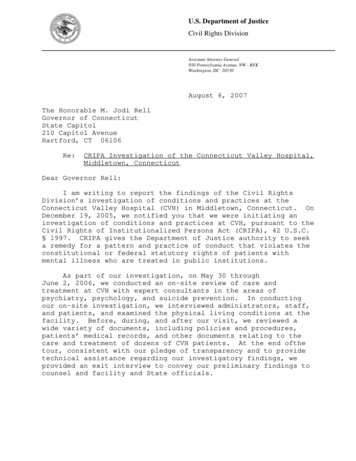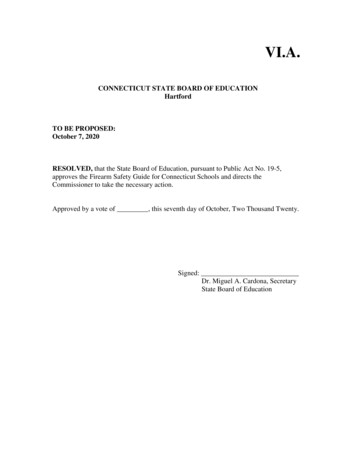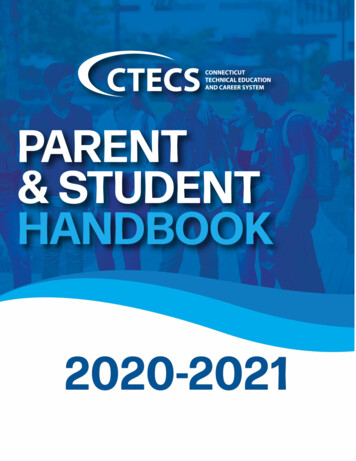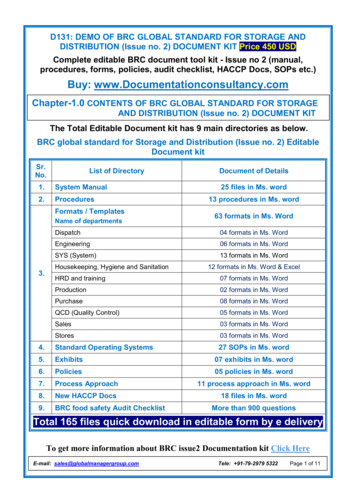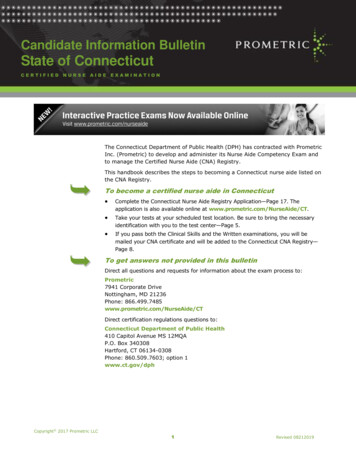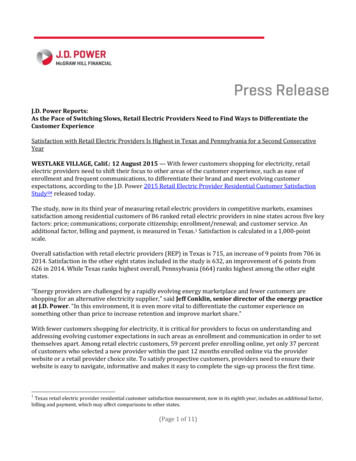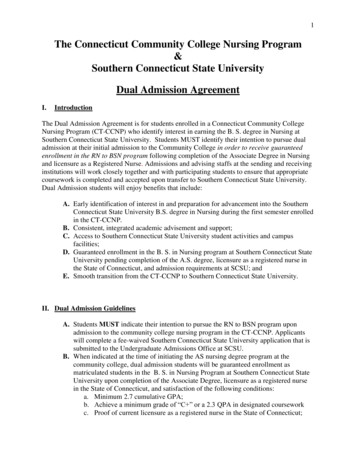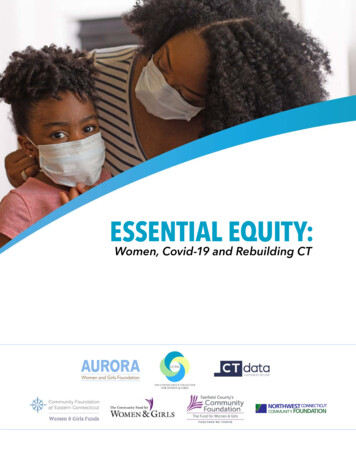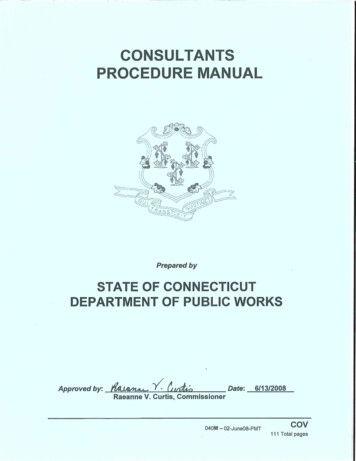
Transcription
Consultant’s Procedure ManualSTATE OF CONNECTICUTDEPARTMENT OF PUBLIC WORKSSECTIONREVISIONCOVER SHEET040M –02 JUN08COV1TABLE OF CONTENTS040M –04 JUN08TOC20.00.10.20.3INTRODUCTION TO DPWTerms and DefinitionsConsultant SelectionConsultant Services040M –02 JUN08040M –03 JUN08040M –02 JUN08040M –02 RATIVE ISSUESContract ProcessContract RequirementsContract FormsConsultant PaymentsGovernmental Agency Exemption CertificateConsultant Performance Evaluation040M –01 OCT05040M –01 OCT05040M –01 OCT05040M –01 OCT05040M –01 OCT05040M –02 42.3.5TECHNICAL REQUIREMENTSPROGRAMMINGDPW’s Responsibility to AgenciesSpace StandardsDaycare FacilitiesFood Service FacilitiesEquipment GuidelinesBuilding SecurityMASTER PLANMaster PlanStudy ExampleSITE - Permits, Approvals, and RequirementsEnvironmental Policy ActStorm Water Discharge StandardsUtility HookupsUnderground Storage TanksPermits, Certifications and Approvals Checklist andPoliciesBoundary and Topographic Survey RequirementsSubsurface Investigation RequirementsBUILDING – Code ReviewDPW Checklist for Permits, Certification and ApprovalsCultural Resources (Historical & Archaeological)ArtworkEnergy Issues (CL&P and UI; LCCA)Material Testing LaboratoriesElevator Inspection by OSBI –Bureau of ElevatorsFire Protection and Water SupplyTelecommunications and Data SystemsDemolitionHazardous Materials040M –02 JUN082.16040M –02 JUN082.1.35040M –01 OCT052.21040M –02 JUN08040M –02 JUN08040M –02 JUN08040M –02 JUN08040M –02 JUN082.3.12.3.22.3.32.3.42.3.524112040M –01 OCT05040M –01 OCT052.3.62.3.742040M –02 JUN08040M –02 JUN08040M –02 JUN08040M –01 OCT05040M –01 OCT05040M –02 JUN08040M –02 JUN08040M –01 OCT05040M –01 OCT05040M –01 2.4.52.4.62.4.72.4.82.4.92.4.10PAGE040M – 04 JUN08-PMT#TOC1 of 2
Consultant’s Procedure ManualSTATE OF CONNECTICUTDEPARTMENT OF PUBLIC .03.13.23.33.4SECTIONREVISIONPAGE#Building ComponentsPROJECT PHASESForwardPre-design PhaseSchematic Design Phase Checklist (35%)Design Development Phase Checklist (60%)Contract Document Phase Checklist (100%)Bidding PhaseConstruction Phase040M –02 JUN082.4.1111040M –02 JUN082.52040M –02 JUN08040M –02 JUN08040M –02 JUN08040M –02 JUN08040M –02 RAWING REQUIREMENTSPREPARED BY A/ESpecification Information – GeneralDrawing Information - GeneralUnit PricesSingle Source Specifications040M –02 JUN08040M –02 JUN08040M –01 OCT05040M –01 OCT053.13.23.33.41221Total Pages111Note: Forms noted in the Consultant’s Procedure Manual shall be referenced by form name and (wherepossible) form number. DPW is working on producing all forms on the DPW’s web site. At this time formsare not available on the web site. The Consultant shall use the most current version of the form in/on theirdocuments. If there is any question of what version is to be used, contact your DPW Project Manager.040M – 04 JUN08-PMTTOC2 of 2
Consultant’s Procedure Manual0.0INTRODUCTION TO DEPARTMENT OF PUBLIC WORKS (DPW)0.0.1Purpose of this ManualThis Consultant Procedure Manual is an information resource to any Consultant that doesbusiness with the State of Connecticut through the Department of Public Works FacilitiesDesign and Construction. This manual includes information on how to obtain state work, whatbasic services consists of and what constitutes extra services for a consultant, administrativeissues and technical requirements. The structure of DPW and how the various people interactwith a project is also explained in the Consultant’s Procedure Manual.0.0.2Department of Public Works Mission StatementTo be the leader in providing quality facilities and in delivering cost-effective, responsive, andtimely services to state agencies in the areas of planning, design, construction, facilitiesmanagement, leasing and real property disposition. With our diverse and competentworkforce, to partner with our customers and industry providers to make the best use of theState’s resources.0.0.3Organization of the Department of Public Works (DPW)The Department of Public Works consists of units that cover Management and Planning,Facilities Management, Leasing Services, and Facilities Design and Construction.0.0.3.1 Under Management and Planning the DPW oversees Asset Planning, as a StatewideService for the full range of State-owned property – all building and lands, but excludinghighways, airports, etc. This effort relates to space management and space utilization, capitolspending, planning deferred maintenance, land & building inventory and some environmentalrecords. The goal is to maximize the use of and value of these assets.0.0.3.2 Under Facilities Management the DPW provides office space, utilities and building servicesfor most state agencies located in Hartford. DPW also, operates district (regional) offices atseveral locations and the Governor’s residence. DPW Facilities Management takestemporary custody and interim maintenance of the surplus properties being sold by the state.0.0.3.3 Leasing Services is responsible for leasing and property acquisitions for most stateagencies as well as facility management, maintenance and security of state buildings in thegreater Hartford area. In addition DPW has certain properties outside of the Hartford area,and surplus property statewide. Leasing supports land sales and purchases with legal andnegotiation support if requested.0.0.3.4 Under Facilities Design and Construction the DPW has responsibility for the majority of theState’s building construction- both new and renovation. This includes statewide service forearly planning and budgeting and design oversight for minor and major projects. Design, bid,build is the most common delivery system. Design build is used for some major projects andwe are venturing into the use of CM at Risk as well. DPW is responsible for the Building Codecompliance process for non-threshold state construction projects. DPW has the primary stateresponsibility for hiring architects, engineers, construction administrators and constructioncontractors related to building and facility projects. DPW handles Energy Management as aStatewide Service, for all agencies and includes technical advice and oversight on energyprojects and policy, in a joint effort with the Office of Policy and Management (OPM). Thisincludes performance energy contracting, utilities joint savings project and Life Cycle CostAnalysis (LCCA) administration. DPW also provides Technical Resources, as a StatewideService, for all state agencies related to buildings design and improvements; and themanagement of several statewide programs – such as all Underground tank replacements,ADA support, and Asbestos and Lead Removal.040M – 02 JUN08-PMT0.01 of 2
Consultant’s Procedure ManualOrganization of Facilities Design and ConstructionFacilities Design and Construction has been divided into four (4) teams that handle allAgency needs throughout the State. Each Team deals with a variety of Agencies to enable usto balance the work load equally among the teams.0.0.3.5 One Team covers Agencies as follows: the Technical High School System, Department ofMental Health and Addiction Services (DMHAS), Department of Public Safety (DPS),Department of Social Services (DSS), Police Officers Standards Training Council (POST),and Department of Developmental Services (DDS)0.0.3.6 Another Team covers the Connecticut State University System., Department of Public Works(DPW), Department of Environmental Protection (DEP), Department of Children and Families(DCF) and Board of Education and Services for the Blind (BESB)0.0.3.7 Another Team covers Judicial, Department of Corrections (DOC), Military, Department ofVeterans Affairs (DVA), American School for the Deaf (ASD), Connecticut AgriculturalExperiment Station (CAES), Fire Schools, and Department of Information Technology (DOIT)0.0.3.8 Another Team covers Community Technical Colleges (CTC), Department of Mental Healthand Addiction Services (DEMHS), Department of Motor Vehicles (DMV), State Library,Department of Public Health (DPH), Department of Agriculture, and the Regional Market0.0.3.9 Each Team has a number of individuals that have the necessary professional qualifications tocomply with their Agencies requirements for their specific projects. A Team may consist ofthe following types of staff: Assistant Director of Project Management (ADPM) [Team Leader], Project Managers (PM’s), Associate Project Manager (ASPM) Assistant Project Managers (APM) Secretarial support.The ADPM’s overview the Team to assure the Agencies needs and personnel issues arebeing met. The PM or ASPM is directly responsible for the project, and is typically the maincontact with the Agency and the Consultant on a day to day basis. The APM’s are the projectsupport staff that have professional expertise in construction, codes, mechanical, electrical,or other expertise that can compliment the PM or ASPM in overview of specific projects.0.0.4DPW SUPPORT:The structure of the Department of Public Works also includes different support groups thatinclude: hazardous materials (Asbestos, Lead), Construction, Architectural, Engineering, RiskManagement, Affirmative Action, Property Disposal & Acquisition, Facilities Management,Energy, Environmental, Code Services, Underground tanks and Claim management. Thesegroups lend support to the Teams and are called on when necessary for specific projects.0.0.5Authority of the Department of Public WorksThe Department of Public Works through its Facilities Design and Construction unit isresponsible for most new building and capital improvements to State property and buildings.The authority of the Department of Public Works is defined under Section 4b-1 of theConnecticut General Statutes (CGS) which states that the responsibility resides with theCommissioner of Public Works and his delegates.040M – 02 JUN08-PMT0.02 of 2
Consultant’s Procedure Manual0.1 Terms and DefinitionsACCEPTANCE OF THE WORK: The Owner’s issuance of a Certificate of Acceptance to theContractor in accordance with CGS § 4-61(b) (2), as amended. The Certificate of Acceptance shalldesignate the Owner’s and Contractor’s responsibilities for completion of all incomplete Work asrequired by the Agreement.Addendum: A document prepared by the Consultant that modifies the plans and/or specificationsafter a project is put out to bid but before the bids are received.ADDITIONAL OR DELETED WORK: Work required by the Department that, in the judgment of theCommissioner, involves any addition to, deduction from, or modification of the Work required by theContract Documents.Affidavit: A statement of facts which is sworn to (or affirmed) before an officer who has authority toadminister an oath (e.g. a notary public). The person making the signed statement takes an oath thatthe contents are, to the best of their knowledge, true. It is also signed by a notary or some otherjudicial officer that can administer oaths, affirming that the person signing the affidavit was under oathwhen doing so.AGENCY: The (User) Agency of the State of Connecticut having administrative authority of thefacility in which the Work is being performed.Amendment: A revision to a contract between a consultant and the state with a value over 100,000.Serves as a change to modify a fixed fee contract.APPLICATION FOR PAYMENT, PARTIAL PAYMENT OR REQUISITION: Contractor’s certifiedrequest for payment for completed portions of the Work and, if the Contract so provides, for materialsor equipment suitably stored pending their incorporation into the Work.ARCHITECT OR ENGINEER (or Consultant): A sole proprietor, partnership, firm, corporation orother business organization under contract with the Owner, commissioned to prepare Con-tractDrawings and specifications, to advise the Owner and in certain cases, to perform regular inspectionsduring construction and when authorized to perform the duties of the Construction Administrator.AS-BUILT DRAWINGS: Construction Drawings revised by the Contractor to show all significantModifications made during the construction process.Attorney General’s Office: A Constitutional Office of the Executive Branch of Government of theState of Connecticut having statutory authority for reviewing and approving as to form, all contractsissued by the various State Agencies.BASE BID: Monetary value stated in the Bid Proposal form as the sum for which the bidder offers toperform the Work described in the Bidding Documents, exclusive of adjustments for SupplementalBids.BID BOND: Form of bid security executed by the Bidder as Principal and by a Surety to guaranteethat the Bidder will enter into a Contract within a specified time and furnish any required bond asmandated by CCS § 4b-92.BIDDER: A sole proprietor, partnership, firm, corporation, or other business organization submitting aBid on the Bid Proposal Form for the Work contemplated.BIDDING DOCUMENTS: Collectively, the Bidding Requirements and the proposed ContractDocuments, including any addenda issued prior to receipt of Bids.040M – 03 JUN08-PMT0.11 of 8
Consultant’s Procedure ManualBID OR BID PROPOSAL FORM: A complete and duly signed proposal to perform Work (or adesignated portion thereof) for a stipulated sum submitted in accordance with the BiddingDocuments.BID SECURITY: Certified check or Bid Bond submitted with Bid Proposal Form, which provides thatthe Bidder, if awarded the Contract, will execute such Contract in accordance with the requirementsof the Bidding Documents.Bond Commission: A sub-unit of the Executive Branch of Government of the State of Connecticuthaving statutory authority for reviewing and approving all requests for bonding of funds by all StateAgencies. Currently the Bond Commission is constrained by both a fiscal year and a calendar yearcap on spending.Building Permit: A document issued by the Department of Public Safety’s Office of the StateBuilding Inspector permitting construction of buildings and/or structures that exceed certainthresholds defined in the Connecticut General Statutes.BUILDER’S RISK INSURANCE: A specialized form of property insurance which provides coveragefor loss or damage to the Work pursuant to the Contract Documents.CASH ALLOWANCE: An amount established in the Contract Documents for inclusion in theContract Sum to cover the cost of prescribed items not specified in detail, and as shown in theAllowance Schedule.CERTIFICATE OF ACCEPTANCE: (DPW form #782) A document issued by the Owner to theContractor stating that all Work specified in the Certificate of Acceptance has been completed andaccepted by the Owner.Certificate of Completion: (DPW form #780) This form is no longer used.CERTIFICATE OF COMPLIANCE: A document stating that for the portion of the project completed,either the design portion or the construction portion has been performed in substantial compliancewith all applicable building codes. (This document is used in lieu of the Certificate of Occupancy usedby the State Building Inspector [SBI])CERTIFICATE OF FUNCTIONAL COMPLETION: A document issued by the Owner to theContractor stating that all remaining TAB and commissioning responsibilities of the contractor andsubcontractors are complete.CERTIFICATE OF OCCUPANCY: Document issued by the authority having jurisdiction certifyingthat all or a designated portion of a building is approved for its designated use. (Only issued when theauthority having jurisdiction is SBI, DPW issues the Certificate of Compliance)CERTIFICATE OF SUBSTANTIAL COMPLETION: A document prepared by the Architect andapproved by the Owner on the basis of an inspection stating: that the Work, or a designated portion thereof, is determined to be Substantially Complete; the date of Substantial Completion; the responsibilities of the Owner and the Contractor for security maintenance, heat, utilities,damage to the Work and insurance; and the time within which the Contractor shall complete the remaining work.CHANGE ORDER: (DPW form #737) Written authorization signed by the Owner, authorizing amodification in the Work, an adjustment in the Contract Sum, or an adjustment in the Con-tract Time.040M – 03 JUN08-PMT0.12 of 8
Consultant’s Procedure ManualCOMMISSIONER: The State of Connecticut, Department of Public Works (DPW) Commissioneracting directly or through specifically authorized DPW personnel or agent(s) having authority toperform duties defined in Article 26.Commission Letter: A revision to a contract between a consultant and the state with a value under 100,000. . Serves as a change to modify a fixed fee contract. Can also be used to extend the periodof time stated in an on-call contract.COMMISSIONING (CX):Commissioning is a systematic process of ensuring that all buildingsystems perform interactively according to the design intent and the owner’s operational needs. Thisis achieved by beginning in the design phase and documenting design intent and continuing throughconstruction, acceptance, and the warranty period with actual verification of performance. Thecommissioning process shall encompass and coordinate the traditionally separate functions ofsystem documentation, equipment startup, control system calibration, testing and balancing,performance testing and training. Commissioning during the construction phase is intended toachieve the specific objectives as described in the Contract Documents.COMMISSIONING PLAN (CX PLAN): The Commissioning Plan is provided as part of the biddocuments and is binding on the Contractor. The commissioning plan provides the structure,schedule, and coordination planning for the commissioning process. After the initial commissioningcoordination meeting with the Contractor, Subcontractors, Construction Administrator, and A/E theCommissioning Authority (CxA) will update the plan which is then considered the “Final”commissioning plan. The Final Commissioning Plan is binding on the General Contractor. TheProject Manual shall take precedence over the Commissioning Plan.COMMISSIONING AUTHORITY (CxA): The CxA is an independent agent, not otherwise associatedwith the Contractor and is hired by the Owner. The CxA directs and coordinates the day-to-daycommissioning activities. The CxA does not take an oversight role like the CA. The CxA is part ofthe Construction Administrator’s (CA) team and shall reports directly to the CA. The Owner’s CxAissues the Certificate of Functional Completion.CONNECTICUT STATE UNIVERSITY SYSTEM 2020 (CSUS 2020) PROJECT:A projectauthorized in accordance with the "The Connecticut State University System Infrastructure Act".CONSTRUCTION ADMINISTRATOR: A sole proprietor, partnership, firm, corporation or otherbusiness organization, under contract or employed by the Owner commissioned and/or authorized tooversee the fulfillment of all requirements of the Contract Documents. The authorized ConstructionAdministrator may be a Department of Public Works Assistant Project Manager, Department of PublicWorks Project Manager, Department of Public Works Associate Project Manager, a Clerk of theWorks, an Architect, a Consulting Architect, a Consulting Construction Administrator, a ConsultingEngineer etc. or any other designee as authorized and identified by the Owner.CONSTRUCTION CHANGE DIRECTIVE: A written authorization signed by the Owner, directing amodification in the Work and stating a proposed basis for adjustment, if any, in the Contract Sum,Contract Time or both. Any Construction Change Directive resulting adjustment of the Contract sumor Contract time shall result in a Change Order.Construction Manager at Risk - Guaranteed Maximum Price (CMR-GMP): Means a projectdelivery system where a construction manager provides both construction management and generalcontractor services for the project. These services are provided to DPW based on a guaranteedmaximum price, fixed price, or other means defined in a contract.CONSTRUCTION START DATE OR DATE OF COMMENCEMENT OF THE WORK: The date,specified by the Owner in the Notice to Proceed, on which the Contractor is required to start theWork.040M – 03 JUN08-PMT0.13 of 8
Consultant’s Procedure ManualCONTRACT DOCUMENTS OR CONTRACT (construction phase): The Agreement betweenOwner and Contractor, Conditions of the Contract (General Conditions, Supplementary Conditions,General Requirements, and other Conditions), Drawings, Specifications, and Addenda issued prior toexecution of the Contract, other documents listed in the Agreement and Modifications issued afterexecution of the Contract, all of which shall constitute the Contract.Contract (Consultant’s): An agreement between a Consultant and the State for services. Theagreement will describe the scope of services typically in an “exhibit A” and the contract will notefees, time frames, and deliverables involved.Contract (on-call): A Contract between a Consultant and the State, that states a maximum feeamount, a duration of a specific number of years, and describes the types of services that theconsultant may be asked to provide. However, the specific project, exact scope of work andcorresponding fee will be identified subsequently in a series of “Task Letters”.CONTRACTOR OR GENERAL CONTRACTOR: A sole proprietor, partnership, firm or Corporation,under direct contract with the Department of Public Works, responsible for performing the Work underthe Contract Documents. Whenever the words “Contractor” or “General Contractor” are used it shallbe understood to mean Contractor.CONTRACTOR’S LIABILITY INSURANCE: Insurance purchased and maintained by the Contractorthat insures the Contractor for claims for property damage, bodily injury, or death.CONTRACT SUM: The sum stated in the Contract, which is the total amount payable by the Ownerto the Contractor for performance of the Work under the Contract Documents.CONTRACT TIME: The period of time allotted in the Contract Documents for Substantial Completionof the Work, including authorized adjustments thereto. The days specified, calendar days, arestipulated in the Bidding Documents.DAY: Whenever the word Day is used it shall be understood to mean calendar day stated on theBidding Documents, unless stated otherwise.DEPARTMENT OF PUBLIC WORKS PROJECT MANAGER or PROJECT MANAGER: Theindividual employed by the Owner, designated, and authorized by the Commissioner, to beresponsible for the overall management and oversight of the Project, and to represent the (User)Agency.Design-Bid-Build (D-B-B): Means a project delivery system in which DPW sequentially awardsseparate contracts, the first for architectural and engineering services to design the project and thesecond for construction of the project in accordance with the design.Design-Build (D-B): Means a project delivery system in which DPW enters into a single D/BContract with a Proposer for the design and construction of an infrastructure facility on a total costbasis in accordance with CSG § 4b-24 (4).EQUAL (S):: A replacement for the specified material, device, procedure, equipment, etc., which hasbeen determined by the Architect and the Owner to be substantially identical to the first listedmanufacturer or first listed procedure specified in terms of cost, quality and performance for theProject. The Equal does not constitute a modification in the scope of Work, the Schedule, orArchitect/Engineer’s design intent of the specified material, device, procedure, equipment, etc.FINAL INSPECTION: Review of the Work by the Architect and Owner to determine whetherAcceptance has been achieved.040M – 03 JUN08-PMT0.14 of 8
Consultant’s Procedure ManualFINAL PAYMENT: The last payment made by the Owner to the Contractor, made after notice of theAcceptance. Payment shall include the entire unpaid balance of the Contract Sum as adjusted byModifications.Fixed Fee Contracts: A contract between a consultant and the state, stating a fixed fee for a specificscope of work related to a specific project.Fixture, Furniture and Equipment (FF&E): Movable furniture and panels and interior design shallbe negotiated to be provided by the consultant OR provided by the Agency under the Equipmentbudget line item.FUNCTIONAL COMPLETION: Functional Completion is when all remaining TAB and commissioningresponsibilities of the contractor and subcontractor’s (except for seasonal or approved deferredtesting and controls training), have been certified as complete by the Owner’s CommissioningAuthority (CxA) and the Certificate of Functional Completion has been issued.GENERAL CONDITIONS: The General Conditions of the Contract for Construction, part of Division00 of the Specifications.GENERAL REQUIREMENTS: That part of the Contract Documents entitled General Requirements,which is Division 01 of the Specifications.GUARANTEE: See Warrantee.LEADERSHIP IN ENERGY AND ENVIRONMENTAL DESIGN (LEED) GREEN BUILDING RATINGSYSTEM : LEED is a third party certification program and the nationally accepted benchmark forthe design, construction, and operation of high performance green buildings. LEED provides toolsimmediately measure the buildings’ performance. LEED is a whole-building approach to sustainabilityby recognizing performance in five key areas of human and environmental health: sustainable sitedevelopment, water savings, energy efficiency, materials selection, and indoor environmental quality.LIQUIDATED DAMAGES: A sum established in a Contract, usually as a fixed sum per calendar day,as the predetermined measure of damages to be paid to the Owner due to the Contractor’s failure tocomplete the Work as stipulated in this Contract.LUMP SUM: An item or category priced as a whole rather than broken down into its elements.Minor Changes in the Work: Changes in the Work not involving an adjustment in the Contract Sumor an extension of the Contract Time and not inconsistent with the intent of the Contract Documents,which shall be affected by written order issued by the Architect.Modification or Amendment: 1.) A written change to the Contract Documents. 2.) A Change Order.3.) A Construction Change Directive. 4.) Supplemental Instructions for minor changes in the Workand/or additional instructions to the Work.MOBILE SOURCE: A source designed or constructed to move from one location to another duringnormal operation except portable equipment and includes, but is not limited to, automobiles, buses,trucks, tractors, earth moving equipment, hoists, cranes, aircraft, locomotives operating on rails,vessels for transportation on water, lawnmowers, and other small home appliances.NOTICE TO BIDDER: A notice contained in the Bidding Document informing prospective Bidders ofthe opportunity to submit Bids on a Project.040M – 03 JUN08-PMT0.15 of 8
Consultant’s Procedure ManualNOTICE TO PROCEED: Written notice, issued by the Commissioner or the Commissioner’sauthorized representative, to the Contractor authorizing the Contractor to proceed with the Work andestablishing the date for commencement of the Contract Time.OWNER OR DEPARTMENT: The State of Connecticut, Department of Public Works acting throughits Commissioner or specifically authorized Department personnel or agent.OVERHEAD: Indirect costs includeings but is not limited to: supervision (any position over theforeman), field, and home office expense, insurance, and small tools and consumables areautomatically calculated by the DPW change Order process and added to the value of the actual workof the Change Order.Note: DPW’s Change Order process does not recognize a contractor or subcontractor overhead(indirect cost) costs since DPW gives a generous, overhead and profit percentage based upon theactual value of the work that is automatically calculated in the “Change Order Workbook (DPW form#735F)” and added to the actual cost of the Work of the Change Order.PAYMENT BOND, LABOR BOND OR MATERIAL BOND: A bond in which the Contractor and theContractor’s surety guarantee to the Owner that the Contractor will pay for labor and materialsfurnished for use in the performance of the Contract, as required by CGS § 49-41.PERFORMANCE BOND OR SURETY BOND: A bond in which the Contractor and the Contractor’ssurety guarantee to the Owner that the Work will be performed in accordance with the ContractDocuments, as required by CGS § 49-41.PERFORMANCE SPECIFICATION: A description of the desired results or performance of a product,material, assembly, procedure, or a piece of equipment with criteria for identifying the standard.PLANS OR DRAWINGS: All drawings or reproductions of drawings pertaining to the construction ofthe Work contemplated and its appurtenances.Project: 1) For Design-Bid-Build and Construction Management-At-Risk Guaranteed Maximum Price(CMR-GMP) delivery systems: The Project is the total construction of which the Work performedunder the Contract Documents may be the whole or a part and which may include construction by theOwner and by separate contractors. 2) For Design-Build delivery systems: The Project is the totaldesign and construction of which the Work performed under the Contract Documents may be thewhole or a part and which may include construction by the Owner and by separate contractors.PROJECT MANUAL: The set of documents assembled for the Work which includes, but is notlimited to, Contract Documents, Bidding Requirements, Sample Forms, General Conditions of theContract, General Requirements, and the Specifications.PROPRIETARY SPECIFICATION: A specification that describes a product, procedure, function,material, assembly, or piece of equipment by trade name and/or by naming the manufacturer(s) ormanufacturer’s procedure, exact model number, item, etc., of those products acceptable to theOwner.Record Documents or As-built Drawings: Construction Drawings revised to show all significantModifications ma
Consultant's Procedure Manual 0.0 040M - 02 JUN08-PMT 1 of 2 0.0 INTRODUCTION TO DEPARTMENT OF PUBLIC WORKS (DPW) 0.0.1 Purpose of this Manual This Consultant Procedure Manual is an information resource to any Consultant that does business with the State of Connecticut through the Department of Public Works Facilities Design and Construction.
